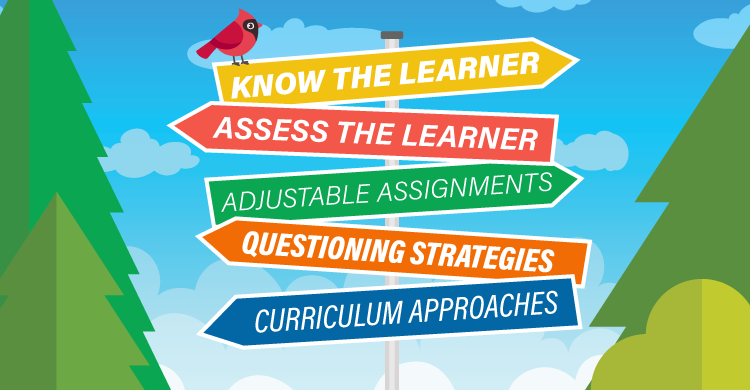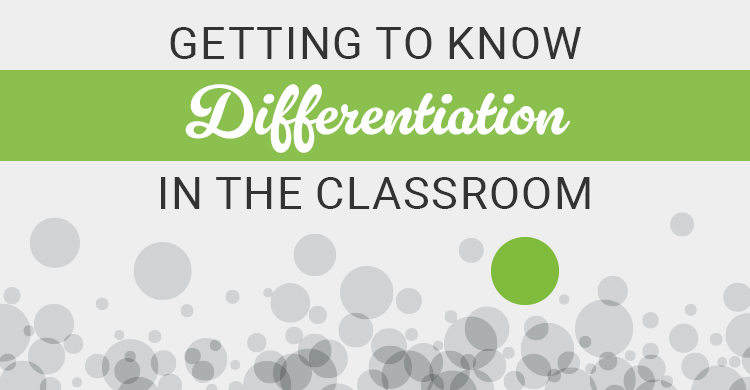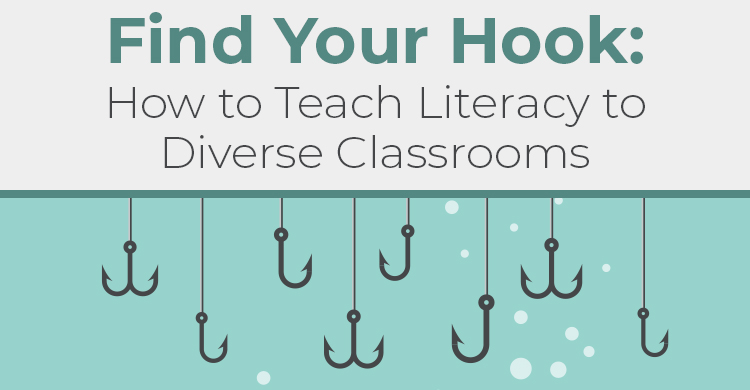Based on 200+ Proven Strategies for Teaching Reading
Looking for successful, easy-to-implement tools and techniques to integrate differentiated reading instruction? You’re in the right place. Read on!
I imagine a literacy program as a maze of intersecting pathways; some of the students travel as a community, and others forge ahead as individuals or small groups. There are multiple routes to reading, and differentiation can lead the way.
Differentiation is certainly getting a lot of buzz lately, but there is no magic wand needed to integrate differentiation into your literacy program. Quite simply, differentiation is adjusting your instruction to meet the unique needs of your diverse learners.
Furthermore, according to Tomlinson (2001), “Differentiating instruction means ‘shaking up’ what goes on in the classroom so that students have multiple options for taking in information, making sense of ideas, and expressing what they learn.” Differentiation is not a single strategy, but an approach to instruction that incorporates a variety of strategies.
When teachers differentiate, they do so in response to a student’s readiness, interest, and learning profile. Because of their unique and diverse literacy needs, our students need us to differentiate the product, process, and/or content of learning.
Differentiation is not …
- Asking every student to read the same text with the same purpose and using the same strategy
- Giving the same instruction and assignments to the whole class
- Giving extra assignments to students who finish early
- Individualized instruction for each student
- Doing something completely different for each student in your classroom
- Creating permanent, labeled groups that never change
Differentiation is…
- More complex than just providing different students with different learning experiences
- Based on the students’ needs
- Considering students’ readiness levels, interests, and learning styles
- A flexible approach to instruction and grouping
- Providing more than one option to the students as they read their texts
- Using different reading strategies to match the material to meet the literacy needs of our students
- Changing the way we teach so that everyone can learn and achieve
The good news is, you can make a real difference in the literacy skills of your students without burning yourself out, with a few key techniques.
To help you create literacy lessons that engage and motivate your students, I have described 20 tools that you can add to your differentiated instruction toolkit today. Remember, choose the ones that will work best for you, your teaching style, and the unique needs of your students.
In other words, there are “different ways of knowing; different ways of showing.” Keep in mind that one size does not fit all. In fact, one size fits few.
Strategies for Differentiating Reading Instruction
Provide flexible grouping patterns
Get away from fixed ability grouping. Students work as part of many different groups, depending on the task and/or content. Groups can be arranged by the teacher or selected by the students. This allows them to work with a wide variety of their peers and gets them away from being labeled as either struggling or advanced.
Keep in mind the acronym TAPS:
- T = Total group instruction
- A = Alone time
- P = Partner work
- S = Small-group work
Choice
Empower students to make choices of activities to complete or as they learn a skill. Choice reading keeps students engaged and moving forward.
Choice boards
Choice boards are organizers that present the students a variety of activities to demonstrate their knowledge of a subject or skill. For instance, instead of assigning a cookie-cutter template of a book report that everyone must complete, why not set up a tic-tac-toe sheet listing many different options to report on a book that has been read and that taps into their interest and learning style?
Some examples include:
- Pantomime a part of the story for others to guess
- Create a story map of main events
- Write a letter to the author explaining why you liked the book
- Make a flip book of the main characters of the story
- Create a puppet show of the plot of the story to share
Literacy centers, interest centers, and/or interest groups
Literacy centers can provide choices or be assigned based on readiness levels. Students can work as part of small groups, depending on the task and/or content. Centers can focus on specific reading skills (e.g., phonics or vocabulary) or provide activities that center on a theme of interest. For a book report, students can work in interest groups with other students who have read the same book.
Here are some other ideas for literacy centers that will help you differentiate:
- Big Book Center
- Writing Center
- Poetry Center
- Drama Center
- Word Work Center
- ABC Center
- Computer Center
- Buddy Reading Center
- Fluency Center
- Comprehension Center
- Listening Center
Learning contracts
Learning contracts are agreements between the teacher and the student. The teacher describes the needed skills to be mastered and the required components to complete assignments, and the student identifies methods to complete the tasks. This allows students to work at their appropriate pace and fosters their learning styles. It also promotes them to work independently and teaches them planning skills.
Give students meaningful work, not busy work
Small-group instruction and literacy centers are important, but always keep in mind the goals, objectives, and outcomes of the lesson.
Make the work for all learners appealing and motivating
Don’t provide paper-and-pencil worksheets for the struggling readers while the advanced students are engaged in project-based learning activities.
Take time to teach procedures and routines
Establish “conditions we need to work together” as group norms. Have the students vote on them, agree to them, and keep them posted at all times for reminders. Consider all of the moving parts of your literacy block. How can you help it run smoothly? Model the expected behaviors and practice.
Some pointers to keep in mind:
- How will students work productively in small groups?
- What do they do when they finish their work?
- How do they ask for help?
- How will they assemble for read-aloud time?
- What should they consider in selecting their own books?
- How will they move through the literacy centers?
- How do they work independently and productively if you are busy with a small group?
- How will you minimize noise and extra movement?
Assess regularly on an ongoing basis with informal measures
Differentiation isn’t just about having different students do different things. Differentiated instruction is based on student needs. Ongoing formative assessment is the key. Plan how you will use the results to differentiate.
3-2-1
- Students jot down three ideas, concepts, or issues presented.
- Students jot down two examples or uses of idea or concept.
- Students write down one unresolved question or a possible confusion.
Idea wave
Each student lists three to five ideas about the assigned topic. One volunteer begins the idea wave by sharing an idea. The student to the right of the volunteer shares one idea; the next student to the right shares one more idea.
The teacher directs the idea wave until several different ideas have been shared.
Exit tickets
In exit tickets, students write responses to questions posed at the end of a class or learning activity or at the end of a day.
Numbered heads huddle
Each student is assigned a number. Members of a group work together to agree on an answer. The teacher randomly selects one number. Students with that number answer for their group.
Hand signals
Ask students to display a designated hand signal to indicate their understanding of a specific concept or process:
- I understand ____________ and can explain it (e.g., thumbs up).
- I do not yet understand ____________ (e.g., thumbs down).
- I’m not completely sure about ____________ (e.g., wave hand).
Structure your reading block for differentiation
Try something new. It is hard to differentiate with a literacy block of whole-class instruction the entire time. Start with a whole-class mini-lesson of no more than 10 minutes. Incorporate a targeted reading skill: comprehension strategy, word-solving, vocabulary, etc. Then provide time for choice in independent reading and/or literacy centers. This gives you time to meet individually or with small groups for targeted instruction. Conclude with a brief sharing session.
Tiered assignments
Tiered assignments are designed to instruct students on essential skills that are provided at different levels of complexity. The curricular content and objectives are the same, but the process or products are modified according to the student’s level of readiness. For example, students with moderate comprehension skills are asked to create a story map, whereas students with advanced comprehension skills are asked to retell the story from the perspective of one of the main characters.
Target different senses and learning styles within lessons
Rethink how lessons can be presented using a range of learning styles by:
- Playing video clips
- Using infographics
- Providing audiobooks
- Using creative dramatics and role-play to act out scenes of a story
- Using charts and illustrations with text
- Providing verbal and written directions to tasks
- Using realia and other physical objects to explain key concepts
- Allowing time for artistic reflections and symbolic summaries
Make time for journaling and quick-write activities
Don’t be afraid to press the pause button and have students reflect on the lessons you’ve taught or stories they have read.
Explore literature circles
Organizing students into literature circles encourages them to share their understanding of the readings, and helps auditory and participatory learners retain more information by getting more involved. This also gives you an opportunity to informally assess their comprehension as you listen to their discussion, asking questions and promoting a deeper understanding.
Assign open-ended projects
Get away from the cookie-cutter approach to assignments. Give students a list of possible projects that can demonstrate their understanding of the lesson. This encourages them to work at their own pace, engage actively with the content, and showcase their distinct learning styles.
Wrapping up
Use these differentiated instruction strategies and techniques to meet the diverse needs and learning styles of your students as they engage in the multiple pathways to literacy. After all, the purpose is reaching the widest range of students with their various entry points to learning.
Take it slow and be easy on yourself. Keep adding new strategies to your toolbox each year … slow down to go faster … and have fun!
References:
Perez, K. (2016). 200+ proven strategies for teaching reading. Bloomington, IN: Solution Tree Press.
Tomlinson, C. (2001). How to differentiate instruction in mixed-ability classrooms. Alexandria, VA: Association for Supervision and Curriculum Development.[author_bio id=”900″]






